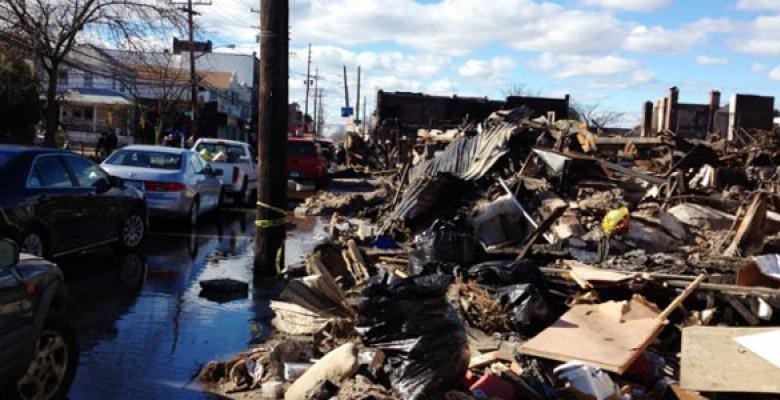Hurricane Sandy Two Years Later: Five Questions with Adam Sobel
Atmospheric scientist Adam Sobel is author of the new book Storm Surge: Hurricane Sandy, Our Changing Climate and Extreme Weather of the Past and Future. A professor at Columbia University’s Engineering School and Lamont-Doherty Earth Observatory, Sobel is an expert in extreme weather and its relation to climate.

Before Sandy even hit the New York metropolitan area, he began explaining to media and the public what might be brewing. In its aftermath, he examined the factors driving the storm’s unusual ferocity and how these played against human weaknesses. His book offers a primer on what drives storm systems, and what we know (and don’t) about their relation to a warming climate. Sobel also looks into future weather, urban infrastructure and the politics of global climate change. (Learn more at his Storm Surge blog.)
Q: To what extent are “natural disasters” truly natural, as opposed to humans playing a role?
A disaster needs the natural event plus human vulnerability. Although the trend in hurricanes is not detectably upward recently, the trend in economic damage is rapidly rising. That’s because of the growing concentration of people, infrastructure and wealth on vulnerable coastlines. In the United States, the coasts are being developed by the wealthiest people, which puts a lot of money in harm’s way. In the developing world, it’s sometimes the opposite: the coastlines are often settled by the poorest people, which puts a lot of life in harm’s way. Either way, we are developing the coastlines without much regard for the hazards.
Q: How does Hurricane Sandy fit in our latest understanding of how climate affects weather?
The world’s climate is warming due to greenhouse gases, but there are many uncertainties in how that affects weather. My colleagues and I talk about the uncertainties so much that we don’t emphasize what we do know. First of all, you can never attribute any one storm to climate change. But you can ask: is a storm like Sandy more probable? Many of the best models indicate there may be fewer hurricanes in the future, at least globally–but we do believe that hurricanes will become more intense. Sandy was an unusual storm, with a complicated scenario that isn’t related to climate change in any way we understand yet. But because of human-induced climate change, we know that the sea level is rising, and that added more than a foot to the total flood level. In the future, the level will go up more, and that will greatly increase the chance of coastal flooding, even if the storms themselves don’t change in intensity. The bottom line is, our risk for major disasters is going up, even though many details of the storm risk are much more uncertain.
Q: Many people saw Sept. 11, 2001, as a turning point in how they saw the world. Was Hurricane Sandy that kind of moment?
When Sept. 11 hit, it seemed to come from nowhere, and it was easy to imagine that something even worse might come at any time. Sandy wasn’t like that. It had been imagined quite clearly long before, by many people who envisioned that the subways would flood and everything else, due to climate change. But it was amazing to watch the attitudes of the general populace, media and politicians evolve. You could really see that the politicians didn’t have canned responses for it. But the groundwork had been laid, because scientific experts had already described this storm in the future tense. The larger society was then saturated with media coverage. We started hearing about “the new normal,” that this was a “wakeup call.” Well, those are clichés, and the “new normal” is maybe a bit of an overreaction. But it seems like there was a new awareness.
Q: How good was the immediate response to Sandy?
All things considered, it went pretty well. Evacuating some neighborhoods and closing down the transit system were the right decisions. Probably the worst decision was not evacuating nursing homes and medical facilities. But it’s easy to second-guess. In the immediate aftermath, in places where government wasn’t getting in, you had the Occupy movement and volunteers from other organizations that did a lot of the work assisting those most in need. So the system worked, even in instances where there was no official system.
Q: How well has government responded to the long-term issues?
Some of the more obvious, less difficult things are getting done. Power stations that blew out are going to have much higher seawalls. The Metropolitan Transportation Authority is working, and already has a new submarine-quality door on their switch room for the N and R lines. Mayor Bloomberg’s team put out a city plan that was really impressive. But then he left office, and the money isn’t necessarily there, so I don’t know how much of the longer-term stuff is really going to happen. One thing we need is a more serious discussion about getting people out of areas where it’s unwise for them to live. But it’s hard to ask people to leave. The first thing Bloomberg said was, we’re not retreating from the waterfront. Well, some day, you probably have to, so there’s a bit of denial there. We’ll have to wait and see–the legacy is still being laid down.
— Interviewed by Kevin Krajick